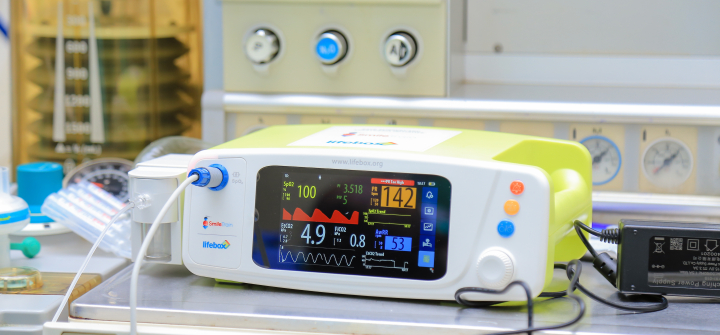Anesthesia Without Capnography: ‘Like Flying Blind’
The color of her blood darkened. That’s how I knew that my patient was starved of oxygen.
I’ll never forget that critical moment back in 2001, when I was an anesthesia resident administering general anesthesia to Patience*, a pregnant woman who needed a cesarean section, at Kenyatta National Hospital, in Kenya.
When I put a patient under general anesthesia, I take away their ability to breathe on their own. I become responsible for their breathing, which requires inserting a plastic “breathing tube” into the windpipe to provide oxygen. This is known as “intubation.” It sounds simple, but if the tube is placed incorrectly into the esophagus—a dark slit next to the windpipe—it can result in esophageal intubation, a life-threatening condition where the patient is deprived of oxygen. This is a leading cause of harm to patients undergoing anesthesia in low-resource settings.
We eventually managed to intubate Patience. However, the baby required resuscitation, and Patience had to spend time in intensive care due to brain swelling from lack of oxygen.
Had our operating room been equipped with a capnograph—a noninvasive device that monitors how adequately a patient is breathing and can detect esophageal intubation—the risk of harm would have been dramatically lower. It would have immediately shown that the tube wasn’t in the correct position well before Patience’s pulse oximeter reading dipped, her blood pressure dropped, and her blood darkened. Capnography has been widely used in operating rooms in high-income countries for over 30 years. Its introduction in the U.S. in 1991 led to a dramatic decline in anesthesia-related complications and deaths.
However, despite being in the largest referral hospital in East and Central Africa, our operating room didn’t have a capnograph. Neither do most operating rooms in my country today. In low-income countries, capnography is often not available at all.

A surgical team at work in CORSU Hospital in Uganda, with a capnograph monitoring device to the right. Image by Muhwezi Davis, courtesy of Lifebox.
While monitors such as pulse oximeters help reduce patient risks, only a capnograph can provide real-time data on every breath, allowing immediate detection if a patient is not receiving oxygen. Administering anesthesia without capnography is like flying blind. It raises stress levels and increases the risks to patients. I can’t forget Patience, or the many other times that lack of equipment in operating rooms has caused preventable harm to my patients. My colleagues and I do everything we can for our patients, but it doesn’t stop us from being heartbroken by the daily inequities that endanger their safety.
Research published in 2020 found that the rate of children dying after surgery in Kenya is 100 times higher than in the U.S. Children are particularly vulnerable to misplaced breathing tubes because of their smaller size and quicker oxygen depletion, leaving less time to avoid harm. Reliable access to capnography would dramatically improve surgical safety for children.
Initiatives like the Smile Train-Lifebox capnograph, designed for low-resource settings, encourage me. However, these efforts alone are not enough to drive systemic change. Achieving universal access to capnography requires a broader commitment from global health organizations, governments, and health care systems to prioritize safer anesthesia practices.
To close the capnography gap in resource-limited countries, the WHO must align global anesthesia guidelines with practices in high-income countries. Updating these standards will increase the demand for affordable capnographs, meeting the growing need for safer surgery in low-resource settings.
As the global burden of disease shifts towards non-communicable conditions like heart disease and cancer, health ministries with limited resources must prioritize surgical systems. Every mother, every child, and every person deserves safe surgery. The recent call by global health organizations at the ALL Africa Anesthesia Congress for the WHO to include capnography as essential monitoring in anesthesia guidelines is a good place to start.
*Pseudonym used for patient confidentiality.
Zipporah Gathuya, MD is an internationally renowned pediatric anesthesiologist with over 20 years of experience in the public and private sectors, currently based at The Nairobi Hospital in Kenya. She is a member of the Global Medical Advisory Board for Smile Train and the Global Initiative for Children’s Surgery secretary. She has a passion for pediatric anesthesia education and was instrumental in setting up and running the Pediatric Anesthesia Fellowship at the University of Nairobi, the first of its kind in East and Central Africa.
Join the 50,000+ subscribers in 170+ countries who rely on Global Health NOW summaries and exclusive articles for the latest public health news. Sign up for our free weekday newsletter, and please share the link with friends and colleagues.
A capnograph surgical monitoring device in a facility in Uganda. Image by Muhwezi Davis, courtesy of SmileTrain / Lifebox.





